Numerical Modelling of Mechanical Behavior of Coal Mining Hard Roofs in Different Backfill Ratios: A Case Study
Abstract
:1. Introduction
2. The SBCM Technique and Study Site
2.1. Basic Principle of SBCM Technique
2.2. Study Site
3. Numerical Modelling
3.1. Model Parameters
3.2. Numerical Simulation Schemes
3.3. Simulation Method of Backfill Materials
(1) Compaction properties of the backfill materials.
(2) Simulation methods used for backfill materials.
3.4. Strain Energy Simulation
4. Analysis of Simulation Results
4.1. Deformation of Hard Roofs
- (1)
- After mining the entire working panel, the maximum subsidence of the hard roof decreases with increasing roof-controlled backfill ratio. When the roof-controlled backfill ratios were 0%, 40%, 60%, 82.5%, 91%, 93% and 97%, the maximum subsidences of the roof were 3130, 2270, 1860, 1180, 1090, 996 and 898 mm, respectively. This indicated that the backfill materials did control the roof subsidence.
- (2)
- The lower the roof subsidence, the lower the gravitational potential energy released by roof deformation. Therefore, with the increase in the roof-controlled backfill ratio, rock bursts are less likely to occur.
4.2. Stope Stress Distributions
- (1)
- Owing to the unloading zone being close to the coal walls of the working panels, the stress is lower than the at-rest stress.
- (2)
- With increasing distance from the panel, the advanced abutment stress increases significantly and reaches a maximum value at between 3 to 6 m from the coal walls and then decreases thereafter. Therefore, this zone is deemd to be a stress elevation zone and the stress in the coal seams is larger than the at-rest stress.
- (3)
- Far from the working panel, the coal seams are only slightly affected by the mining of the working panel, so this area was deemed to have been a zone of at-rest stresses.
- (4)
- The advanced abutment stresses are mainly concentrated within the 45 m in front of the working panel, in particular, the stress is highly concentrated on both sides of the roadways in this area (in a zone from 2 to 15 m deep).
- (1)
- When the roof-controlled backfill ratios are 40% and 60%, the peak value and range of influence of the advanced abutment stress on the working panel are the same with those found when using a caving mining method.
- (2)
- In the case of a varying roof-controlled backfill ratio (82.5%, 91%, 93% and 97%), the advanced abutment stresses on working panels decrease, along with their range of influence. When the ratio reaches 97%, the peak stress decreases from 44.9 MPa while using a mining caving method, to 24.4 MPa: the range of influence of the stresses decreases from 45 m to 25 m, which also significantly reduces the extent of stress concentration in front of the working panel.
4.3. Strain Energy Distributions
- (1)
- The distributions of strain energy in front of the working panel are similar to those of the stresses. When the caving method is used for mining, strain energy is concentrated within the first 45 m in front of the working panel and the maximum strain energy reaches 1545 kJ/m3.
- (2)
- When the roof-controlled backfill ratios are 40% and 60%, the backfill does not affect the energy distribution in front of the working panel, and the strain energy remains concentrated within 45 m of the front surface of the coal walls in the working panel. The maximum strain energies are 1440 kJ/m3 and 1420 kJ/m3, which are similar to those found when using the caving method.
- (3)
- When the roof-controlled backfill ratios are 82.5%, 91% and 93%, the strain energy in front of the working panel significantly decreases and the larger the roof-controlled backfill ratio, the more significant the decrease; however, when the roof-controlled backfill ratios are 91% and 93%, the strain energy in front of the working panel decreases slightly and the peak strain energies are 882 kJ/m3 and 814 kJ/m3, which are similar to that at a backfill ratio of 82.5%.
- (4)
- When the roof-controlled backfill ratio is 97%, the strain energy in front of the working panel rapidly decreases from its peak value of 544 kJ/m3. It decreases by 63.9% and 33.2%, separately, compared with those values found when using the caving method and with a roof-controlled backfill ratio of 93%.
5. Conclusions
- (1)
- Based on the stress-strain relationship for the backfill materials, as obtained experimentally, the non-linear compaction procedure thereof is compiled by using the built-in FISH language in the FLAC3D software. This procedure can simulate the non-linear deformation of backfill materials under the stresses imposed by overlying strata, and can thus analyse the mining process as applied to the backfill panels studied here.
- (2)
- As the roof-controlled backfill ratio increases from 0 to 40% and 60%, only the release of gravitational potential energy in the goafs decreases: this has little effect on the distribution of the advanced abutment stress and strain energy density in the working panel. If the roof-controlled backfill ratios are 82.5%, 91% and 93%, the release of gravitational potential energy, the advanced abutment stress, and the strain energy density in goafs decrease significantly; however, the increase in the roof-controlled backfill ratio at this stage exerts only a slight influence on the reduction. When the roof-controlled backfill ratio reaches 97%, the advanced abutment stress and the strain energy density decrease. The maximum stress concentration factor is only 1.5 and the maximum strain energy density is 544 kJ/m3, decreased of 45.7% and 63.9%, separately, compared with those when the caving method is used.
- (3)
- When the roof-controlled backfill ratios are 40% and 60%, the backfill could only reduce the release of gravitational potential energy, but has no influence on the distribution of the strain energy density in the stopes. This reduces the risk of occurrence of a rock burst arising from the release of gravitational potential energy, however, the dynamic hazards caused by strain energy accumulation and release have little difference to those found when using the caving method. When the roof-controlled backfill ratios are 82.5%, 91% and 93%, the backfill reduces the stope stresses and the strain energy density, which decreases the risk of a rock burst, but the increase in roof-controlled backfill ratio does also slightly influence the preventative effects at this stage. When the roof-controlled backfill ratio further increases to 97%, the stope stresses, release of gravitational potential energy, and strain energy density largely decrease, showing significant rock burst preventative effects.
- (4)
- The rock burst induced by hard roofs will pose a serious threat to the safety of staff and equipment in coal mining. The SBCM technique can be effectively used to solve the problem of rock bursts induced by hard roofs. However, when the backfill materials are filled into the coal mine goaf, the different backfill ratios will lead to quite different control effects. If the backfill ratio is lower, the rock burst will not be controlled. On the contrary, too high backfill ratios will be certain to add to the production costs. Therefore, the control effects including deformation, stress, and energy, of hard roofs in different backfill ratios are studied in this paper. The research results can provide reference to other coal mines with the similar geological conditions.
Acknowledgments
Author Contributions
Conflicts of Interest
References
- Zheng, Z.T.; Xu, Y.; Li, D.S.; Dong, J.H. Numerical analysis and experimental study of hard roofs in fully mechanized mining faces under sleeve fracturing. Minerals 2015, 5, 758–777. [Google Scholar] [CrossRef]
- Wang, W.; Cheng, Y.P.; Wang, H.F.; Liu, H.Y.; Wang, L.; Li, W.; Jiang, J.Y. Fracture failure analysis of hard–thick sandstone roof and its controlling effect on gas emission in underground ultra-thick coal extraction. Eng. Fail. Anal. 2015, 54, 150–162. [Google Scholar] [CrossRef]
- Zhang, J.X.; Li, B.Y.; Zhou, N.; Zhang, Q. Application of solid backfilling to reduce hard-roof caving and longwall coal face burst potential. Int. J. Rock Mech. Min. Sci. 2016, 88, 197–205. [Google Scholar] [CrossRef]
- Rennia, B.K.; Brian, A. Prediction of rock brittleness using nondestructive methods for hard rock tunneling. J. Rock Mech. Geotech. Eng. 2016, 8, 533–540. [Google Scholar]
- Wang, P.; Jiang, J.Q.; Zhang, P.P.; Wu, Q.L. Breaking process and mining stress evolution characteristics of a high-position hard and thick stratum. Int. J. Min. Sci. Technol. 2016, 26, 563–569. [Google Scholar] [CrossRef]
- Zhang, Y.; Cao, S.G.; Lan, L.X.; Gao, R.; Yan, H. Analysis of Development Pattern of a Water-Flowing Fissure Zone in Shortwall Block Mining. Energies 2017, 10, 734. [Google Scholar] [CrossRef]
- Mangal, A.; Paul, P.S. Rock mechanical investigation of strata loading characteristics to assess caving and requirement of support resistance in a mechanized powered support longwall face. Int. J. Min. Sci. Technol. 2016, 26, 1081–1087. [Google Scholar] [CrossRef]
- Tao, X.; Yang, T.H.; Chen, C.F.; Liu, H.L.; Yu, Q.L. Mining induced strata movement and roof behavior in underground coal mine. Geomech. Geophys. Geo-Energy Geo-Resour. 2015, 1, 79–89. [Google Scholar]
- Rahul; Khandelwal, M.; Rai, R.; Shrivastva, B.K. Evaluation of dump slope stability of a coal mine using artificial neural network. Geomech. Geophys. Geo-Energy Geo-Resour. 2015, 1, 69–77. [Google Scholar]
- Xue, Y.; Gao, F.; Teng, T.; Xing, Y. Effect of Gas Pressure on Rock Burst Proneness Indexes and Energy Dissipation of Coal Samples. Geotech. Geol. Eng. 2016, 34, 1737–1748. [Google Scholar] [CrossRef]
- Hamdi, J.; Souley, M.; Scholtes, L.; Heib, M.A.; Gunzburger, Y. Assessment of the Energy Balance of Rock Masses through Discrete Element Modelling. Procedia Eng. 2017, 191, 442–450. [Google Scholar] [CrossRef]
- Wang, J.C.; Jiang, F.X.; Meng, X.J.; Wang, X.Y.; Zhu, S.T.; Feng, Y. Mechanism of rock burst occurrence in specially thick coal seam with rock parting. Rock Mech. Rock Eng. 2016, 49, 1953–1965. [Google Scholar] [CrossRef]
- Lawson, H.E.; Tesarik, D.; Larson, M.K.; Abraham, H. Effects of overburden characteristics on dynamic failure in underground coal mining. Int. J. Min. Sci. Technol. 2017, 27, 121–129. [Google Scholar] [CrossRef]
- Christopher, M. Coal bursts in the deep longwall mines of the United States. Int. J. Coal Sci. Technol. 2016, 3, 1–9. [Google Scholar]
- Mu, Z.L.; Dou, L.M.; Zhang, G.W.; Zhang, S.B.; Li, Z.H.; Zhang, J. Study of prevention methods of rock burst disaster caused by hard rock roof. J. China Univ. Min. Technol. 2006, 35, 737–741. [Google Scholar]
- Guo, W.J.; Li, Y.Y.; Yin, D.W.; Zhang, S.C. Mechanisms of rock burst in hard and thick upper strata and rock-burst controlling technology. Arab. J. Geosci. 2016, 9, 1–11. [Google Scholar] [CrossRef]
- Zubelewicz, A.; Mróz, Z. Numerical simulation of rock burst processes treated as problems of dynamic instability. Rock Mech. Rock Eng. 1983, 16, 253–274. [Google Scholar] [CrossRef]
- Goszcz, A. Roof rock bursts and ways to combat them. Arch. Min. Sci. 1991, 36, 239–261. [Google Scholar]
- Dou, L.M.; Lu, C.P.; Mu, Z.L.; Gao, M.S. Prevention and forecasting of rock burst hazards in coal mines. Min. Sci. Technol. 2009, 19, 585–591. [Google Scholar] [CrossRef]
- Hirata, A.; Kameoka, Y.; Hirano, T. Safety Management Based on Detection of Possible Rock Bursts by AE Monitoring during Tunnel Excavation. Rock Mech. Rock Eng. 2007, 40, 563–576. [Google Scholar] [CrossRef]
- Zhang, J.X.; Jiang, H.Q.; Deng, X.J.; Ju, F. Prediction of the height of the water-conducting zone above the mined panel in solid backfill mining. Mine Water Environ. 2014, 33, 317–326. [Google Scholar] [CrossRef]
- Junker, M.; Witthaus, H. Progress in the research and application of coal mining with stowing. Int. J. Min. Sci. Technol. 2013, 23, 7–12. [Google Scholar] [CrossRef]
- Li, H.Z.; Zha, J.F.; Guo, G.L.; Zhao, B.C.; Wang, B. Compression ratio design and research on lower coal seams in solid backfilling mining under urban areas. Soil Mech. Found. Eng. 2016, 53, 125–131. [Google Scholar]
- Li, M.; Zhang, J.X.; Deng, X.J.; Ju, F.; Li, B.Y. Measurement and numerical analysis of water-conducting fractured zone in solid backfill mining under an aquifer: A case study in China. Q. J. Eng. Geol. Hydrogeol. 2017, 50, 81–87. [Google Scholar] [CrossRef]
- Zhang, J.X.; Zhang, Q.; Sun, Q.; Gao, R.; Germain, D.; Abro, S. Surface subsidence control theory and application to backfill coal mining technology. Environ. Earth Sci. 2015, 74, 1439–1448. [Google Scholar] [CrossRef]
- Ju, F.; Li, B.Y.; Guo, S.; Xiao, M. Dynamic characteristics of gangues during vertical feeding in solidbackfill mining: A case study of the Wugou coal mine in China. Environ. Earth Sci. 2016, 75, 1389–1397. [Google Scholar] [CrossRef]
- Sinha, S.; Chugh, P. An evaluation of roof support plans at two coal mines in Illinois using numerical models. Int. J. Rock Mech. Min. Sci. 2016, 82, 1–9. [Google Scholar] [CrossRef]
- Itasca. Fast Lagrangian Analysis of Continua in 3 Dimension; Version 3.1; User’s Guide: Minneapolis, MN, USA, 2007. [Google Scholar]
- Bai, Q.S.; Tu, S.H.; Chen, M.; Zhang, C. Numerical modeling of coal wall spall in a longwall face. Int. J. Rock Mech. Min. Sci. 2016, 88, 242–253. [Google Scholar] [CrossRef]
- Timoshenko, S.; Goodier, J.N. Theory of Elasticity, 3rd ed.; McGraw Hill: New York, NY, USA, 1970. [Google Scholar]
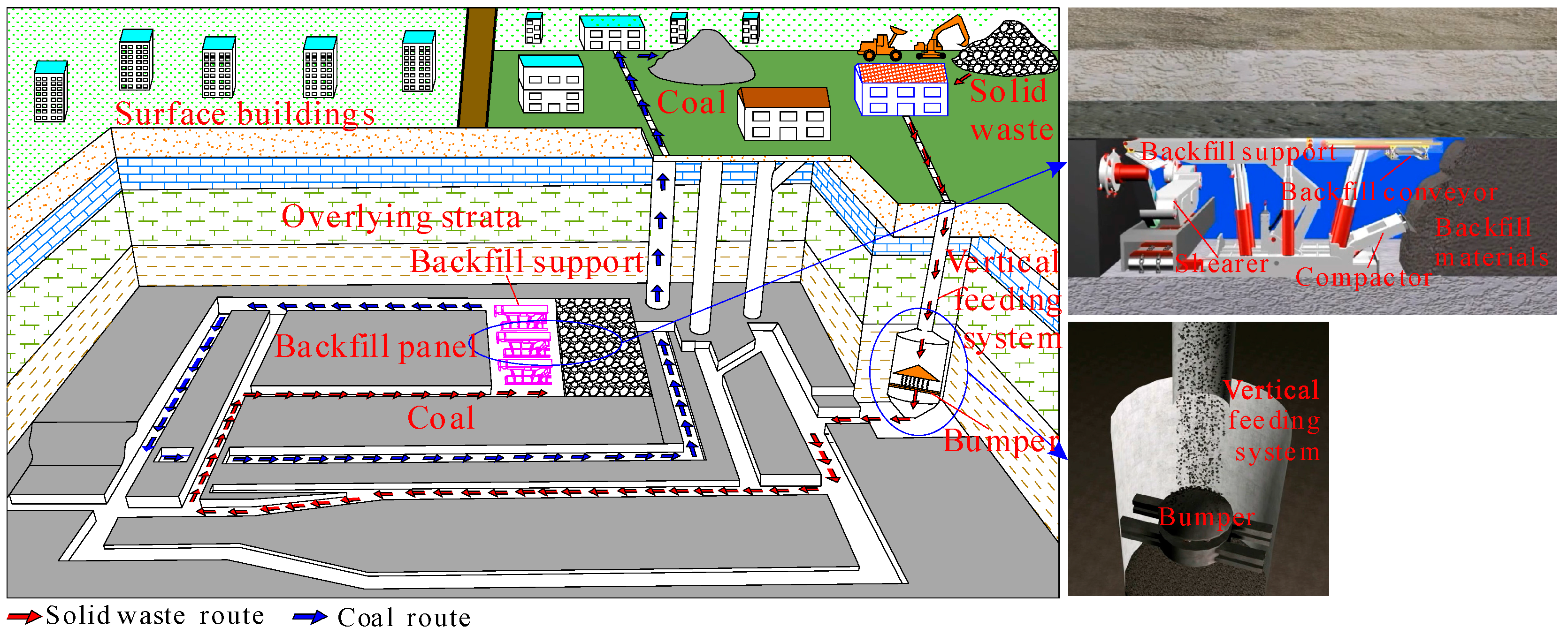


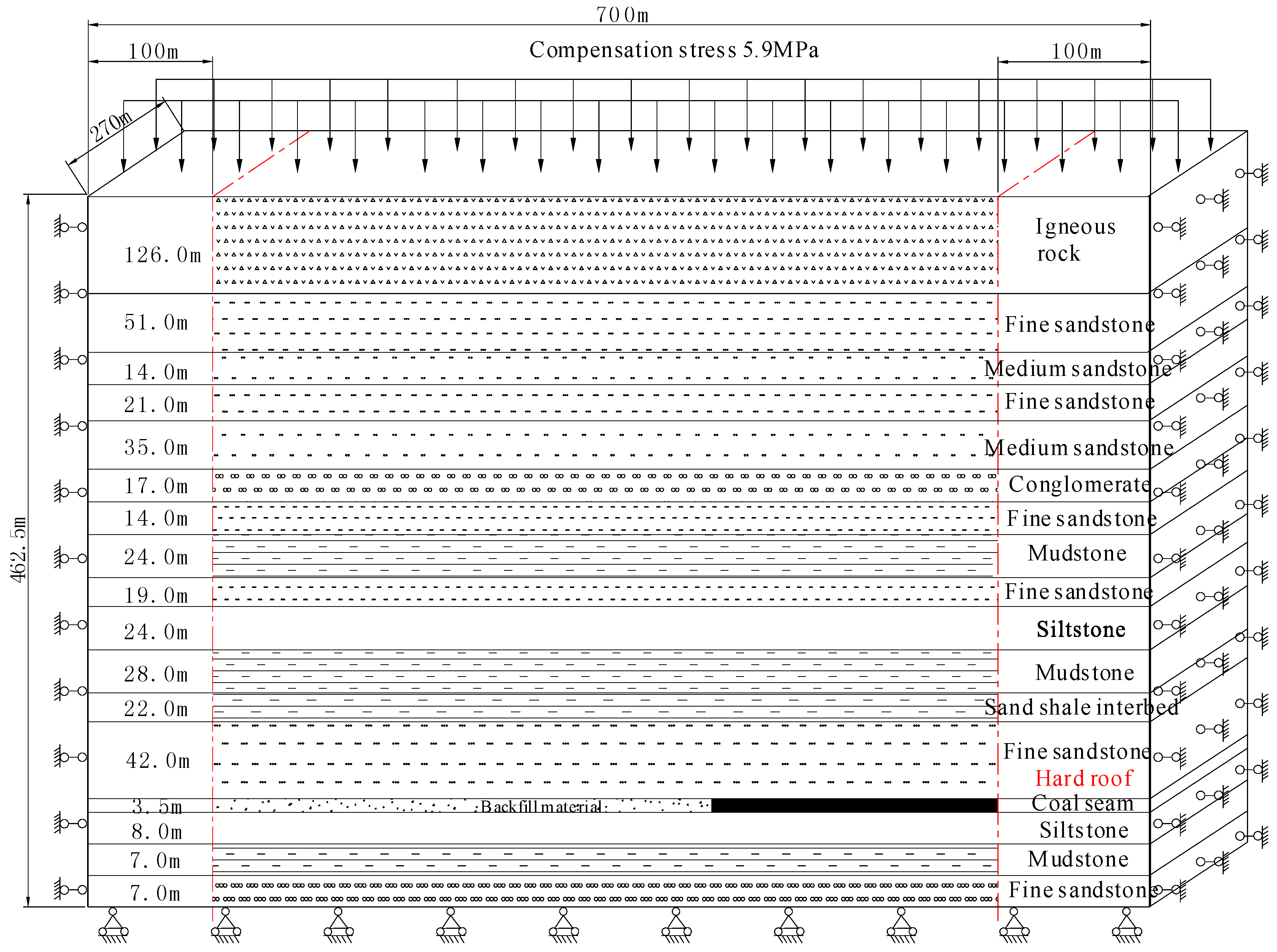

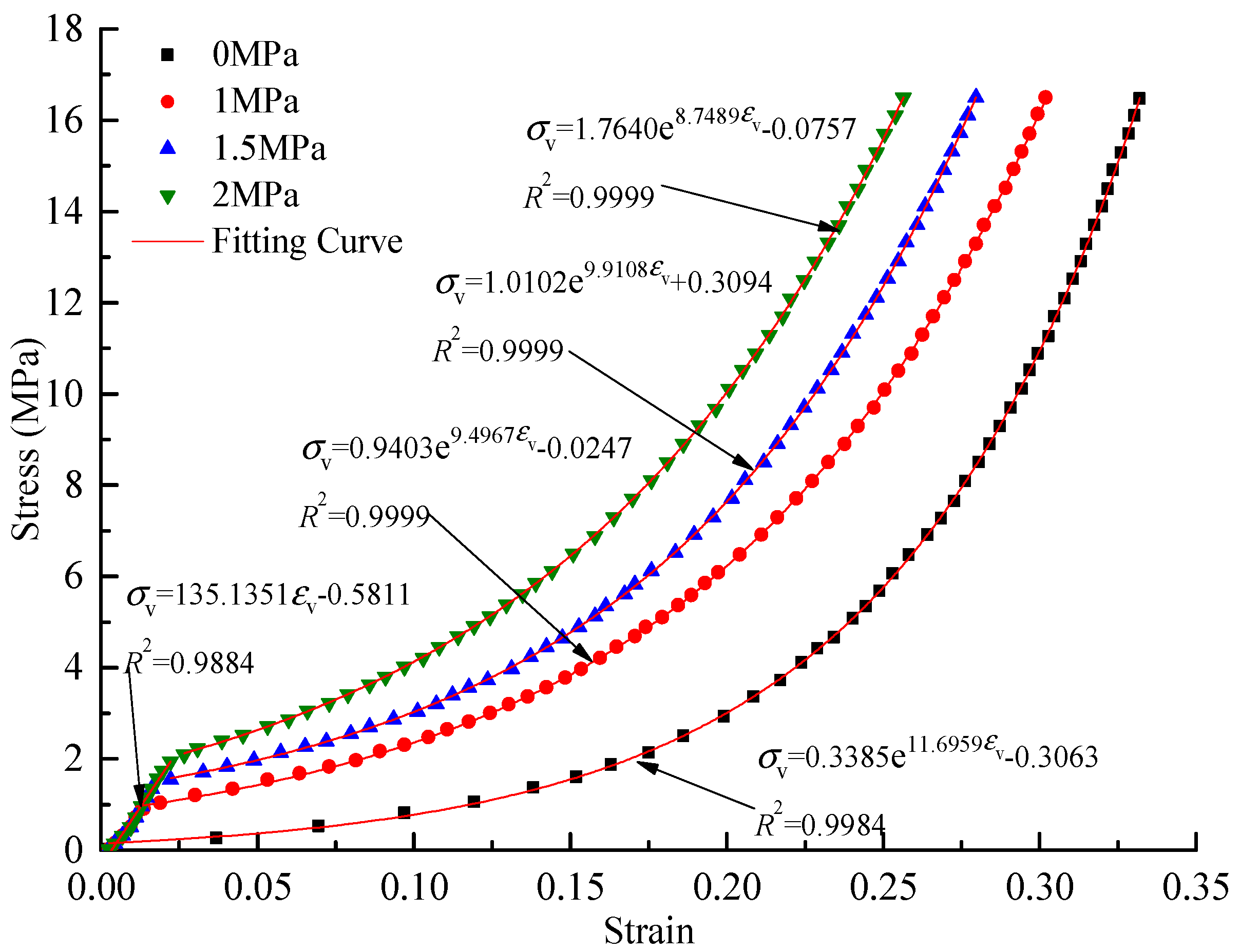
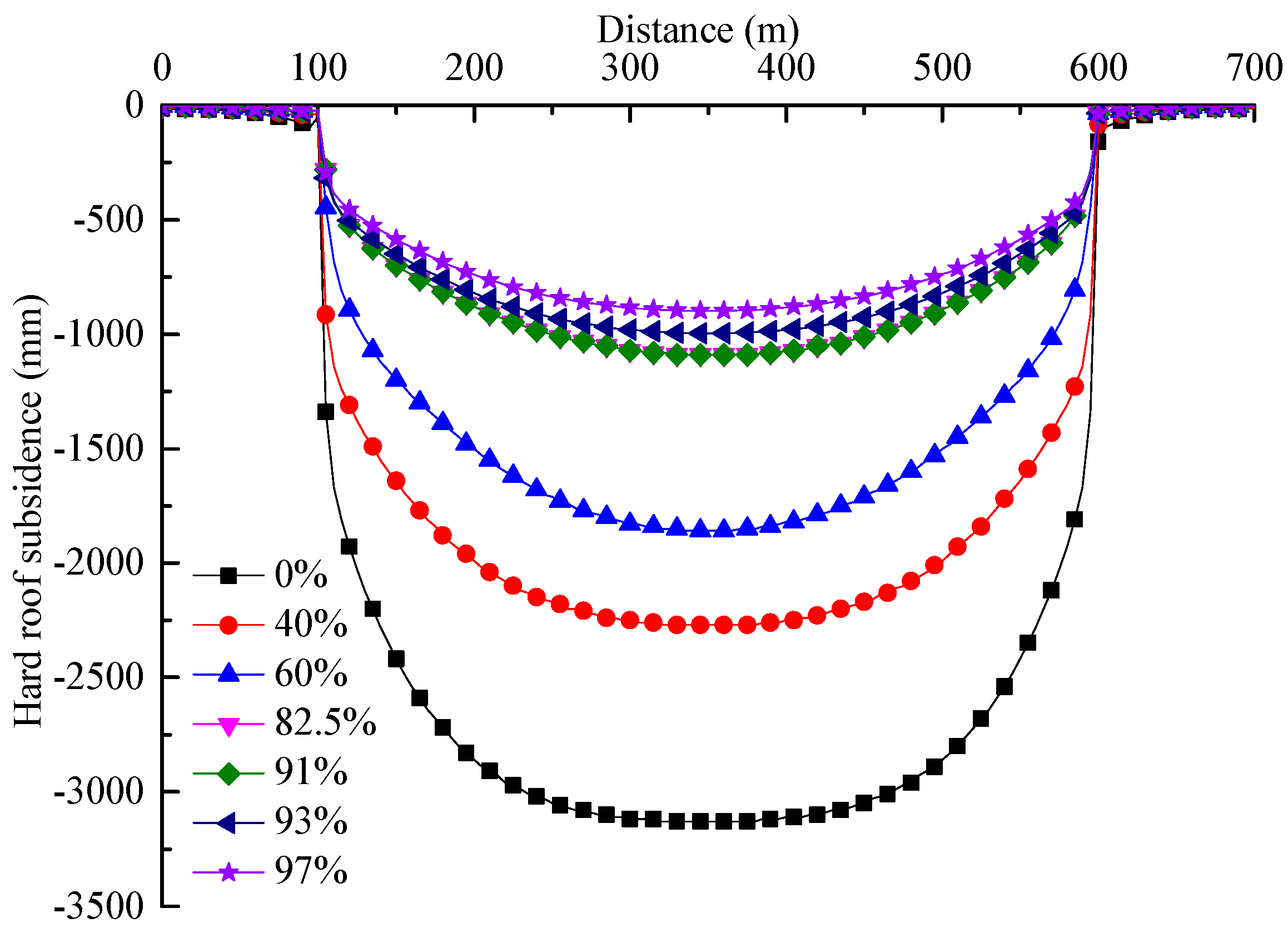
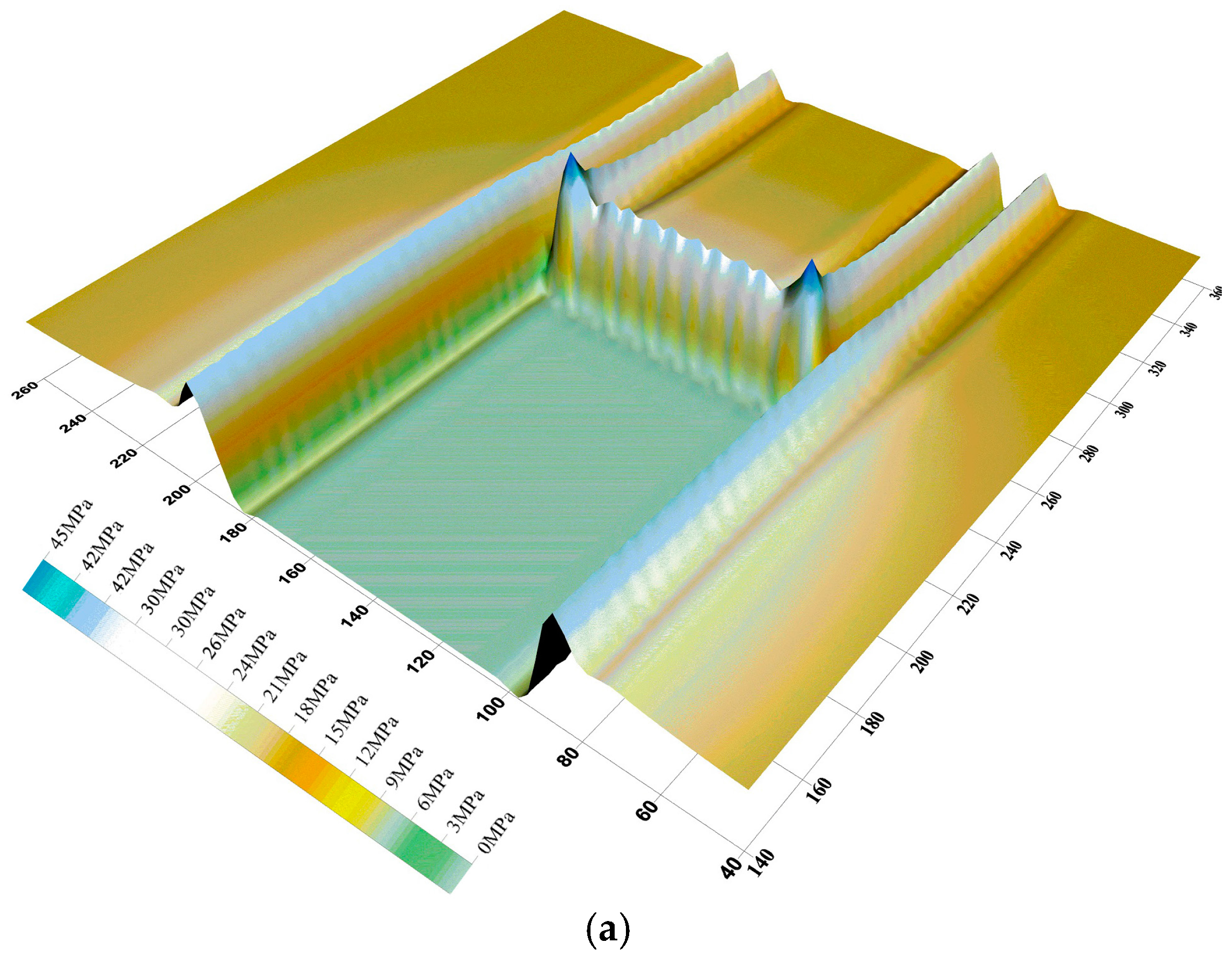



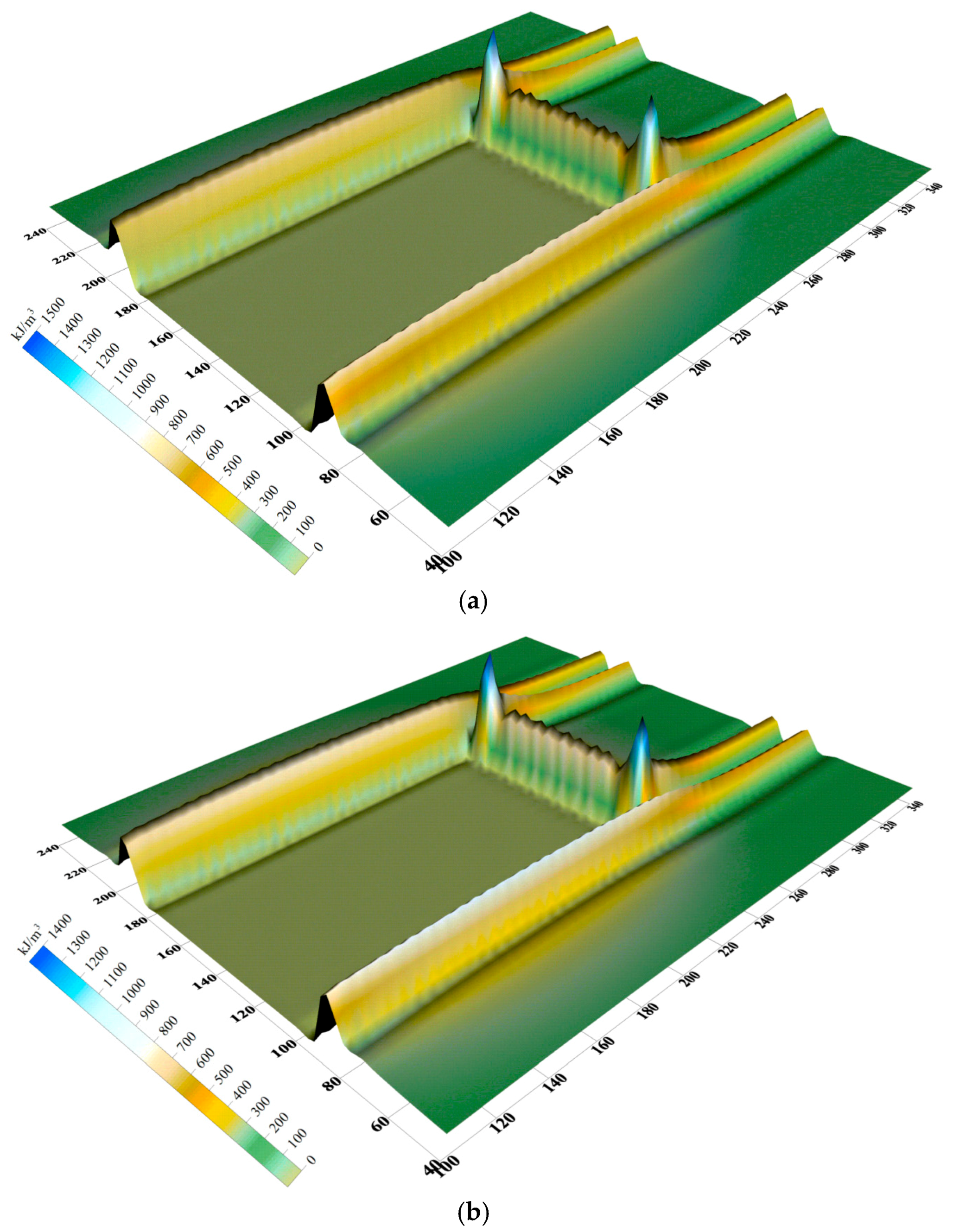
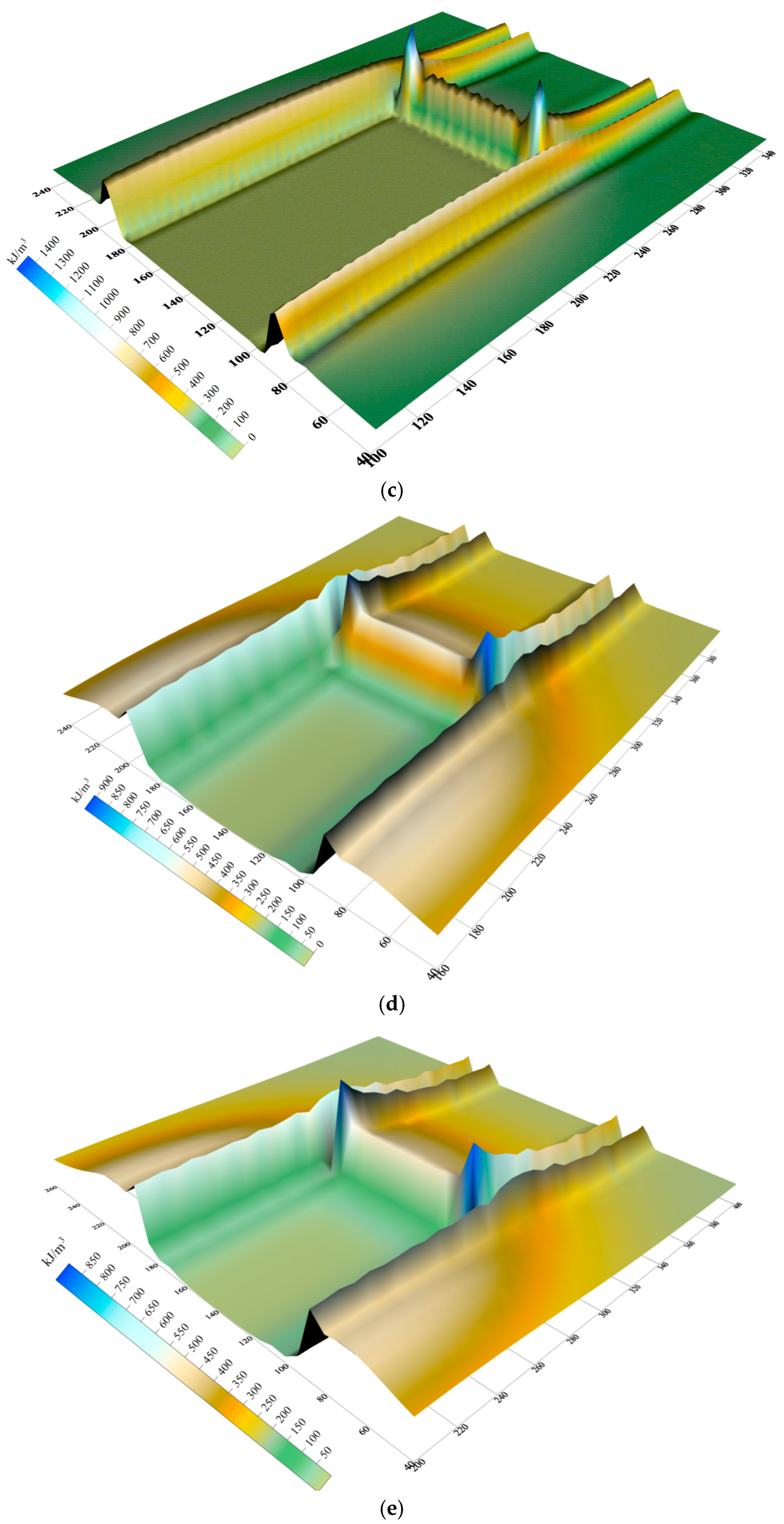
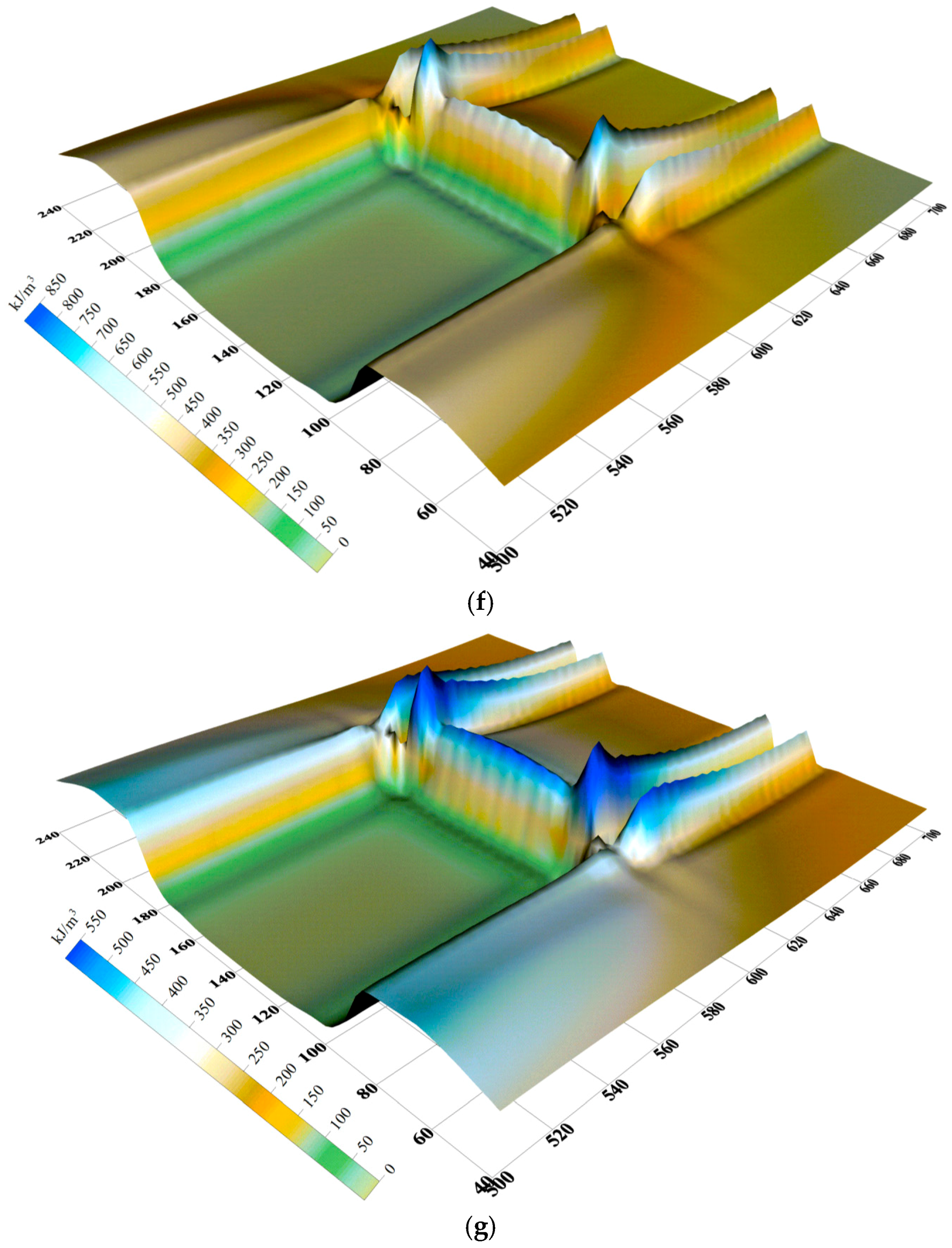
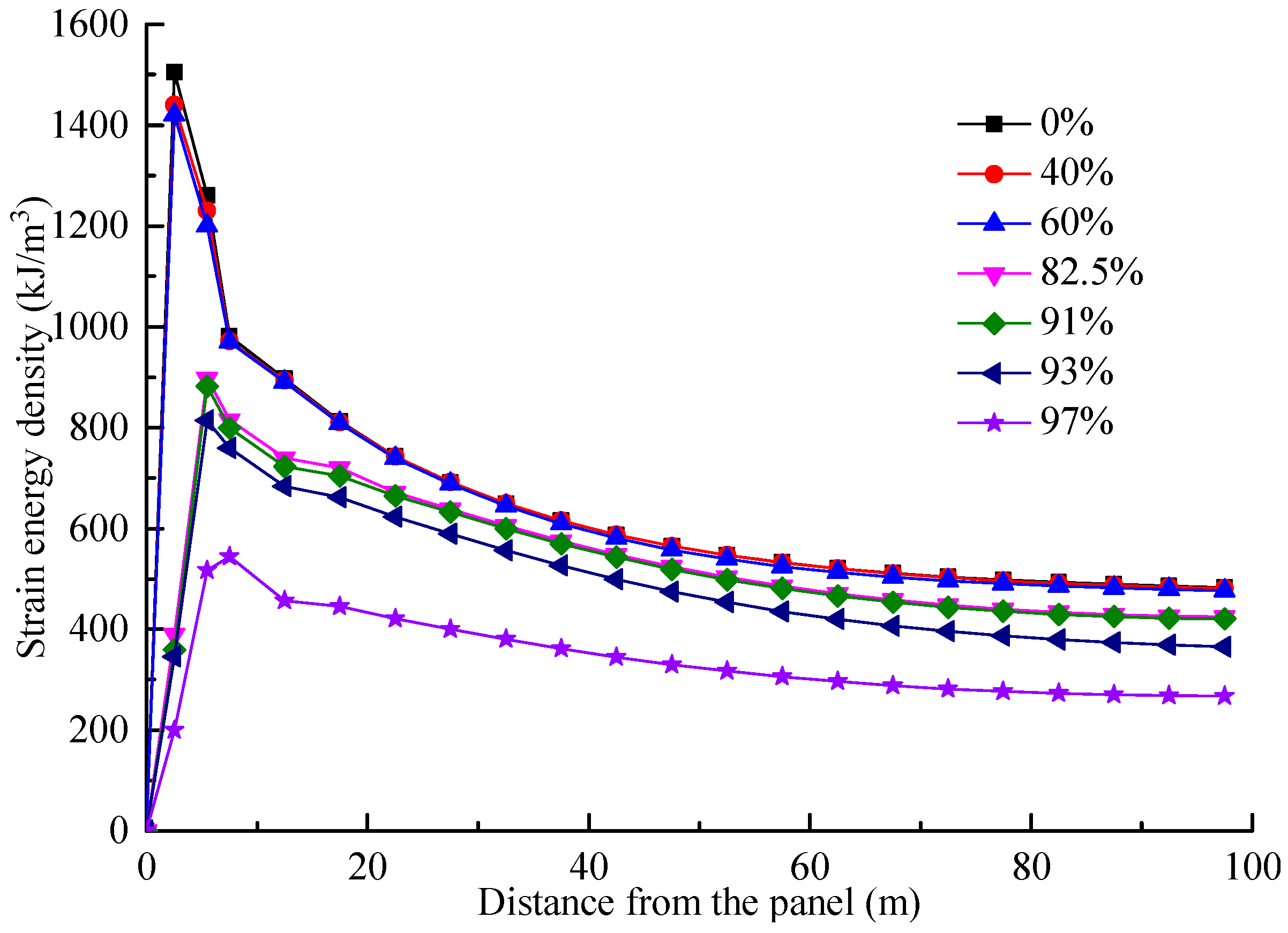
| Mine Area | Rock Category | Thickness (m) | Rock Features |
|---|---|---|---|
| Main roof | Fine- and medium-grained sandstone | 32.5~49.75 41.63 | The rock is grey-white in colour and consists of a lot of quartz, and feldspar with a small amount of dark, green minerals: f = 8~10. |
| Immediate roof | Mudstone | 0.0~1.02 | The rock is brown-grey in colour and contains many plant root fossils: f = 2~3. |
| Immediate floor | Aluminous mudstone | 0.0~3.20 | The rock is light grey in colour and smooth textured, and it contains plant fossil fragments: f = 2~3. |
| Main floor | Fine-grained sandstone | 2.7~8.43 5.85 | The rock is light to dark-grey in colour, and is dense and hard: f = 6~8. |
| Group | Roof-Controlled Backfill Ratio (%) | Backfill Height (m) | Initial Applied Stress (MPa) | Mining Distance (m) |
|---|---|---|---|---|
| 1 | 0 | 0 | 0 | 150 |
| 2 | 40 | 1.75 | 0 | 150 |
| 3 | 60 | 2.50 | 0 | 150 |
| 4 | 82.5 | 3.50 | 0 | 170 |
| 5 | 91 | 3.50 | 1.0 | 195 |
| 6 | 93 | 3.50 | 1.5 | 500 |
| 7 | 97 | 3.50 | 2.0 | 500 |
| Group | Roof-Controlled Backfill Ratio (%) | Initial Applied Stress (MPa) | Stress-Strain Relationship |
|---|---|---|---|
| 1 to 4 | 0, 40, 60, and 82.5 | 0 | |
| 5 | 91 | 1.0 | (0 ≤ σv < 1.0) |
| (1.0 ≤ σv) | |||
| 6 | 93 | 1.5 | (0 ≤ σv < 1.5) |
| (1.5 ≤ σv) | |||
| 7 | 97 | 2.0 | (0 ≤ σv < 2.0) |
| (2.0 ≤ σv) |
| Roof-Controlled Backfill Ratio (%) | Backfill Height (m) | Initial Applied Stress (MPa) | Advanced Abutment Stress (MPa) | Distance between Stress Peak and Coal Rib (m) | Stress Concentration Factor | Influence Distance (m) |
|---|---|---|---|---|---|---|
| 0 | 0 | 0 | 44.9 | 3.0 | 2.7 | 45.0 |
| 40% | 1.75 | 0 | 44.1 | 3.0 | 2.7 | 45.0 |
| 60% | 2.50 | 0 | 42.3 | 3.0 | 2.6 | 45.0 |
| 82.5% | 3.50 | 0 | 33.0 | 6.0 | 2.0 | 35.0 |
| 91% | 3.50 | 1.0 | 30.8 | 6.0 | 1.9 | 30.0 |
| 93% | 3.50 | 1.5 | 28.6 | 6.0 | 1.7 | 30.0 |
| 97% | 3.50 | 2.0 | 24.4 | 6.0 | 1.5 | 25.0 |
© 2017 by the authors. Licensee MDPI, Basel, Switzerland. This article is an open access article distributed under the terms and conditions of the Creative Commons Attribution (CC BY) license (http://creativecommons.org/licenses/by/4.0/).
Share and Cite
Li, M.; Zhou, N.; Zhang, J.; Liu, Z. Numerical Modelling of Mechanical Behavior of Coal Mining Hard Roofs in Different Backfill Ratios: A Case Study. Energies 2017, 10, 1005. https://doi.org/10.3390/en10071005
Li M, Zhou N, Zhang J, Liu Z. Numerical Modelling of Mechanical Behavior of Coal Mining Hard Roofs in Different Backfill Ratios: A Case Study. Energies. 2017; 10(7):1005. https://doi.org/10.3390/en10071005
Chicago/Turabian StyleLi, Meng, Nan Zhou, Jixiong Zhang, and Zhicheng Liu. 2017. "Numerical Modelling of Mechanical Behavior of Coal Mining Hard Roofs in Different Backfill Ratios: A Case Study" Energies 10, no. 7: 1005. https://doi.org/10.3390/en10071005




